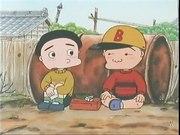"Sunset on Third Street": A thorough analysis of this moving anime classic!

Sunset on Third Street - Sanchoume no Yuuhi - 360 degree evaluation and recommendationoverview"Sunset on Third Street" is a TV anime series that aired on Mainichi Broadcasting System (MBS) from October 12, 1990 to September 21, 1991. It was based on Nishigishi Ryohei's "Sunset on Third Street: Poem of Sunset" and was produced as an original anime. It consists of 18 episodes, each 28 minutes long, and was produced by Group TAC, Toho, and MBS. Set in Japan in the 1950s, this is a heartwarming story about the daily lives of children, friendship, and family love. story"Sunset on Third Street" is set in a town in the 1950s and depicts the daily lives of four children, Ippei, Saburo, Yuichiro, and Yoshiko. Through events at school and life at home, they deepen their friendships and family bonds. Each episode centers on a small adventure, discovery, and story of growth from the children's perspective. For example, everyday events are depicted from the children's perspective, such as competitions at sports day, secret treasure hunts, and New Year's parties with their families. characterThe main characters are:
Production StaffMany talented staff members were involved in the production of "Sunset on Third Street." The original story was written by Nishigishi Ryohei, and it was produced by Mainichi Broadcasting System, Toho, and Group Tac. The character design was by Maeda Tsuneo, the script was written by Hagita Hiroko and Namiki Satoshi, and the direction was by Oguma Kimiharu and Harada Masuji. The animation was by Nomura Seiji and Murata Masahiko, the art was by Shitamichi Kazunori and Shibata Chikako, the cinematography was by Sugimura Juro, and the music was by Haneda Kentaro. The theme songs were sung by Tomita Yasuko and Mori Kumiko, and the sound director was Fujiyama Fusanobu. Thanks to the cooperation of these staff members, "Sunset on Third Street" achieved high-quality animation and a moving story. episode"Sunset on Third Street" consists of 18 episodes, each of which depicts the daily life and adventures of children. The main episodes are listed below:
evaluation"Sunset on Third Street" is highly acclaimed as a heartwarming story set in Japan in the 1950s. Episodes depicting everyday life, friendship, and family love from the children's perspective touched and resonated with viewers. Furthermore, the talent and hard work of the production staff resulted in high-quality animation and a moving story. In particular, the character design, drawings, and music were highly praised, and the show garnered a lot of support from viewers. Recommendation"Sunset on Third Street" is recommended for those who want to enjoy a heartwarming story set in Japan in the 1950s. Episodes depicting daily life, friendship, and family love from the children's perspective will move and sympathize with viewers. In addition, the high-quality animation and moving story have the power to draw viewers in. It is especially recommended for those who are interested in Japan in the 1950s and those who want to enjoy a story about children growing up. Related information"Sunset on Third Street" has been developed not only in the original "Sunset on Third Street/Poem of the Sunset" but also in other media. For example, it has been adapted into movies, stage plays, games, and more, and is loved by many fans. In addition, figures and goods related to the series are also sold, and are essential items for fans. Conclusion"Sunset on Third Street" is highly acclaimed as a heartwarming story set in Japan in the 1950s. Episodes depicting daily life, friendship, and family love from the perspective of children touched and resonated with viewers. Furthermore, the talent and efforts of the production staff resulted in high-quality animation and a moving story. In particular, the character design, drawings, and music were highly praised, and the show garnered a lot of support from viewers. "Sunset on Third Street" is recommended for those who are interested in Japan in the 1950s and those who want to enjoy a story about children growing up. |
>>: The appeal and evaluation of "Yaohachicho Omoteura Keshoushi": the fusion of history and beauty
Recommend
Fans say they have super powers! Saiki K.'s Aso Shuichi will marry the Dempagumi idol
The author of the famous manga "The Disastro...
Johnny Depp receives Lifetime Achievement Award at Rome Film Festival
According to foreign media, Johnny Depp will rece...
John Turturro joins Batman as super villain
According to foreign media reports, the movie &qu...
The latest trailer of the TV animation "Rich Detective" will be broadcast again on July 16 due to the epidemic
The hit TV animation "Rich Man Detective Bal...
Sony's new comedy film "Holmes & Watson" released the first official trailer
The PG-13 comedy film "Holmes & Watson&q...
Netflix is also going to make an animated film called The Witcher: Nightmare of the Wolf
The second season of Netflix's "The Witc...
The appeal and reviews of "Dimension High School": New possibilities for a school in another world
"Dimension High School": A story of adv...
"Borderlands" live-action movie received 6 Golden Raspberry nominations, including Worst Picture
The annual Golden Raspberry Awards has announced ...
Tiger Mask: Masked League - A thorough review of the fierce battles between legendary wrestlers
Tiger Mask: Masked League - Movie Review and Deta...
The appeal and reviews of "Midoriko": An anime experience not to be missed
All-round review and recommendation of Midori-ko ...
The appeal and evaluation of "Saber Marionette J Program:26 Plasmatic Crisis"
"Saber Marionette J Program:26 Plasmatic Cri...
The first trailer for the animated film Batman and Superman: Battle of the Incredible Twins
Today (July 1), the first trailer of the new DC a...
Initial D anime sequel "MF GHOST" renewed for second season
The sequel to the Initial D animation "MF GH...
Rail Romanesque 2 Season 2: A journey of evolution and deepening that exceeds expectations
The appeal and evaluation of the second season of...
The appeal and reviews of "Vampire Holmes": A new world of vampire detectives
The appeal and reviews of "VAMPIRE HOLMES&qu...









